Villarrica is one of the 47 towns that conform the department of Tolima, located in Colombia. Because of the high degree of complexity that its geology presents, its territory is very unstable and make it a high vulnerable place for the effects of earthquakes and rainfalls. Due to this vulnerability, since 30 years ago, the buildings of Villarrica have experienced problems with their structural stability.
In the first months of the current year, Colombia has experienced a rainy season that made worst the integrity of the buildings located in Villarrica. According to the Pan American Health Organization, “the longest and most severe rainy season recorded in 50 years has brought deadly floods and landslides to Colombia. More than 3.2 million people have been affected in 28 departments and the capital district and more than 400 have died since last year. It is expected that the effects of La Niña will last until June, bringing heavy rains and requiring constant alert for Colombia” (Pan American Health Organization, 2018). Because of this phenomenon and the fact that 80% of the sewage system has already collapsed, relief agencies have issued various warning about the possible overflow of the “El Botadero” stream.
Colombian Geological Service (SGC) conducted a study and concluded that Villarrica is at risk due to its proximity to the “El Botadero” stream and the mechanical properties of the ground. As well, they confirmed that the stability of most structures is critical due to the cracks that they present, that the town has been moving 14 millimeters each year and that in the last 2 years the effects of the landslides have affected 5000 habitants, which represent de 80% of the population.
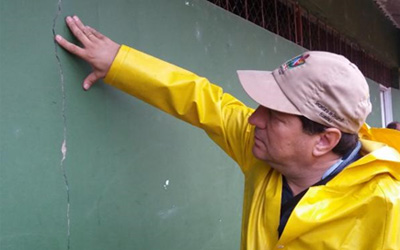
Obrero, Miraflores and Centro are the three neighborhoods that are closer to the stream. Arelis Beltrán, the president of the Community Action Board (JAC) of Obrero, implied that this problem has been present among various years – 30 years approximately – and that the government has not done anything to help its people and provide them with safer houses, even though some of the actual structures have enormous holes.
The 29th of December of 2017, the government declared a public calamity; however, they have not translated the people that is at risk because they do not have enough resources. For that reason, civilians of Villarrica are worried because they thing that if the government cannot help them no one will.
Causes of the Problem
The Delegate Office of the Comptroller for Citizen Participation worked in the study “Villarrica Tolima, a time bomb”, in which it was warned that the situation presented in Villarrica was caused by a fault. In the documents they presented, they implied that the fault originated in 1993; however, it has been intensifying with time at the point that now days is at risk of collapsing the municipality and there is no evidence of policies of the government to mitigate the risk. By the contrary, the geologist Hernando Lozano Quiroga worked in the “Study of the landslides at the south of the municipality of Villarrica, department of Tolima”, in which he stated that Villarrica is under the effect of the geological phenomena known as crawling, landslides and mass movement.

Geological Problems
Marta Calvache – the head of the Colombian Geological Service – stated in 2014 that a study must be done. “We cannot talk about a geological fault because we do not even know for sure what is happening. The study made by the City Hall, which is from 1993, implies that Villarrica area went through a process of crawling, which happened when an unstable mass of earth begins to move very slowly” she implied.
In the same year, Eduardo Rodriguez the secretary of Environment of Tolima stated that the natural phenomenon that affected Villarrica is known as receptation and consists of an imperceptible movement of the ground, which is evidenced by signs as earth staggering, cracks and deformation in buildings.
As well, the Department of Disaster Prevention of Tolima noted that the municipality presents a phenomenon called “receptation” which consists of a slow and imperceptible movement of the ground, which can be identified by signs such as stepping and cracks in the ground, and cracks and deformations in structures.
The threats present in Villarrica are:
- Erosion and landslides in unstable hillside areas.
- Crawling and undermining in the urban area.
- In the sector of Guanacas, rocks that represent high threat are observed.
- Erosion beside the roads.
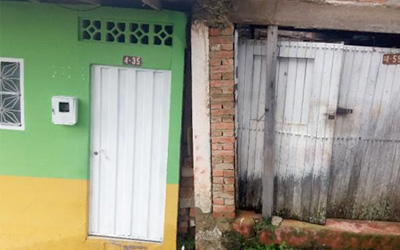
Consequences
Reporters from Caracol Radio – a Colombian radio station – visited Villarrica in April of 2014 and discovered that many buildings were at risk of collapsing, including various homes and schools, not only because of the effects of the fault but because of serious problems with the sewage network. Most of the buildings had numerous cracks, holes and soil sinking which affected more than 200 homes from the 400 that existed in that time in the urban area, which housed 2500 people.
According to Semana – a Colombian magazine – all the streets from the urban area are cracked, sunken and unpaved as well as the road that connects Villarrica from the exterior. On the other hand, various families live in high-risk places because they have nowhere to go.
In March of the same year, the mayoress of Villarrica claimed for help from the President of Colombia, due to its technical and financial impossibility to solve the problem because of the magnitude of it. Due to the lack of stability and safety of the hospital “La Milagrosa”, patients preferred not to be hospitalized there, 624 homes were in bad condition and at least 200 had critical stability and had to be evacuated.
Sadly, this picture has not changed with time because as the study made in 2017 by the Delegate Office of the Comptroller for Citizen Participation confirms; roads, schools, common areas and “La Milagrosa” hospital are still at risk of collapsing due to the enormous cracks their structures present. The report of the study stated “the situation is so serious that people who were in the hospital La Milagrosa had to be evacuated by the imminent threat of collapse of the structure, without having a space so far that physically and structurally guarantees the conditions for the provision of health service”.
Some testimonies of the citizens of Villarrica are shown below.
“My house was filled with cracks overnight, and I had to leave and pay rent elsewhere,” says Maria Eugenia a family mother who says “one of these days my house is going to collapse”.
“The cracks began to appear 5 years now, they got in all the houses” says one citizen, adding, “we do not want to have the same luck people had in Gramalote” referring to the town in Norte de Santander that vanished during the winter of 2010 due to a geological fault.
“Our town is falling apart, I feel that the floor yields and moves constantly” says a woman who has her bags ready to leave her property, in which she has lived for 50 years.
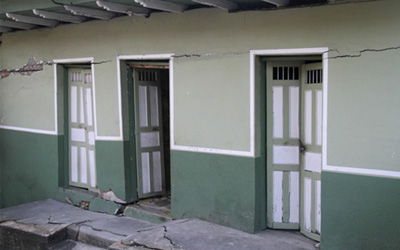
What is the Relationship with “El Botadero” Stream?
Villarrica has been threatened since the end of 2017 by natural emergencies. In December, the municipality was at risk due to the heavy rains, which led to the overflow of “El Botadero” stream and landslides, which affected the stability of most buildings and several people.
Between the second and the third week of January of this year, a flood occurred due to the lack of a wall that is planned to be constructed within the framework of the Action Plan of the Municipality. In the first week of March, due to the amount of rains, the risk got higher and in the second week of March, a new overflow happened.
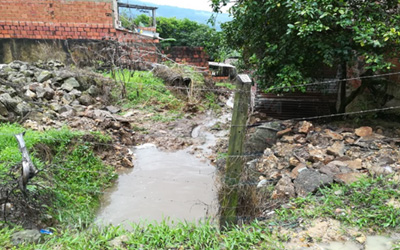
What has been done?
The National Fund for Disaster Risk Management, the Colombian Geological Service, the department of Tolima, the Regional Autonomous Corporation of Tolima and the town of Villarrica combined administrative, financial, physical and technological infrastructure efforts. As a result, they developed Phase 1 of the analysis of physical risk by movements in the urban and the zoning of the rural area by threat due to mass movements.
The activities they have accomplished are:
- Exploratory analysis in the field of superficial Geomorphological Units.
- Sampling of subsurface water and analysis with tracers, to study sub-surface flow lines.
- Geotechnical field exploration using seismic and electrical tomographies, downhole tests and vertical electric soundings (sev) in the municipality of Villarrica - Tolima.
- Analysis of soil samples to determine processes of Geotechnical Instability.
- Geotechnical field exploration by drilling by mechanical rotation in sampling diameter hq, instrumentation and monitoring in the municipality of Villarrica - Tolima.
- Delivery to the Municipal Mayor of Villarrica and the Town Councilors of the municipality, the threat report at a scale of 1: 10000.
The activities that remain incomplete are:
- Structural assessment of affected homes.
- Assessment of basic service systems.
- Evaluation of the estimated damages in the censuses developed in company with the community.
- Construction of the final document that assesses vulnerability and threat at a scale of 1: 2000, in the urban area of the municipality.
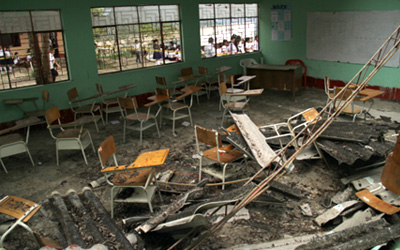
As it was evidenced previously, the situation in Villarrica has not changed in the past 4 years, the society now days confront the same dangers it did 4 years ago. The government should guarantee the safety and stability of all buildings and above all the safety of people and they have failed in that.
A clear example is the situation presented in 2014 in a school, in which the roof of a schoolroom collapsed during a school day. Fortunately, there were no casualties and only two students suffered minor injuries. The government cannot wait to something worst happens to relocate all the buildings that are in danger of collapsing.
As the Delegate Office of the Comptroller for Citizen Participation implied: “there is no response to citizens who live with the imminence of a disaster in subhuman conditions as the gradual deterioration of the entire area. The municipality keeps them isolated and deprived of adequate public services without options of economic activities that meet their needs and waiting for help and a solution that is neither short nor long term”.
Bibliografia:
Espinosa, M. (May 9,2018). Villarrica, el municipio que se cae y debe ser reubicado. Retrieved from http://m.eltiempo.com/colombia/otras-ciudades/villarrica-el-pueblo-tolimense-que-se-se-cae-y-debe-ser-reubicado-215278
Cruz, L. (May 4,2018). Villarrica: el pueblo de la grieta. Retrieved from https://www.semana.com/nacion/articulo/villarrica-el-pueblo-de-la-grieta/382635-3
Vallejo, J ( February 21, 2018). Se desbordó nuevamente la quebrada el Botadero en Villarrica. Retrieved from http://www.ecosdelcombeima.com/region/nota-121188-se-desbordo-nuevamente-la-quebrada-el-botadero-en-villarrica

